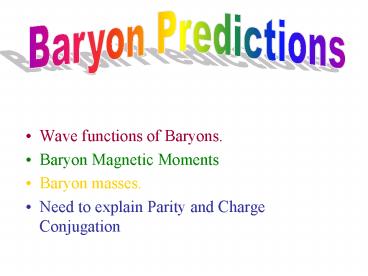Wave functions of Baryons. - PowerPoint PPT Presentation
1 / 16
Title:
Wave functions of Baryons.
Description:
Title: Particle Physics Option Author: Huffman, B. Todd Last modified by: Huffman, B. Todd Created Date: 5/5/1999 6:26:08 AM Document presentation format – PowerPoint PPT presentation
Number of Views:86
Avg rating:3.0/5.0
Title: Wave functions of Baryons.
1
Baryon Predictions
- Wave functions of Baryons.
- Baryon Magnetic Moments
- Baryon masses.
- Need to explain Parity and Charge Conjugation
2
Hadrons Magnetic moments
- mq related to the intrinsic spin S of the quark.
- m (q/mc)S
- and therefore for each spin-up quark
Spin down just changes the sign
3
Hadron Magnetic moments
- Need a particles which are long-lived and have
some intrinsic spin. Proton!
Total Magnetic Moment should equal the vector sum
of the magnetic moments of the constituent
quarks.
Reminder The order of the spin arrows designates
which quark has that spin.
4
Hadron Magnetic moments
Doing the calculation for the first term
So we expect mproton to be
5
Hadron Masses
- Seems Simple enough
- Just add up the masses of the quarks
- Mp Mu Md 2Mu 620 MeV/c2
- Experimentally ? Mp 139 MeV/c2
- What????
p is u, d-bargt. This is a particle made up of
two like-sign charged quarks. Why doesnt it fly
apart?
Strong Nuclear Force!
6
Hadron Masses
Electromagnetic Force
Hyperfine splitting in hydrogen atom Caused by
the spin of the electron interacting with the
spin of the proton
Strong Nuclear Force!
7
Hadron Masses
Strong Nuclear Force!
Masses are more equal, Force is much more
powerful. Fit to some meson masses and find As
160(4pmu/h)2 MeV/c2
S1S2 Meson Calculated Observed p
140 138 r 780 776 K 484
496 K 896 892
8
Hadron Masses
Amazingly we can take the meson mass formula as
the lead for estimating baryon masses
Fit to some baryon masses and find As
50(4pmu/h)2 MeV/c2
Caution There are tricks you need in order to
calculate those spin dot products. Example if
all masses are equal (proton, neutron)
Again see Griffiths, page 182.
9
More Conserved Stuff
- We need to cover some more conserved quantum
numbers and explain some notation before moving
on. - Parity and Charge Conjugation
- Parity Y(x,y,z)?Y(-x,-y,-z) not reflection in a
mirror! - Define the parity operator P such that
- P Y(x,y,z)gt Y(-x,-y,-z)gt
- ?gt is an eigenstate of P if P?gt p?gt
- P2?gt p2?gt ?gt so p ?1
- Parity is a simple group. Two elements only.
10
Eigenstates of Parity
- Suppose we have a force that only acts radially
between two particles. - Then the wave function Y y(r)yqyqbar
- P yqgt ? yqgt -P yqbargt
- Parity is a Multiplicative quantum number, not
additive. - Given q1 and q2
- J S1 S2
- P P1P2
11
Eigenstates of Parity
- For once, Baryons are easy!
- For Mesons with no ang. Momtenum
- PYbgtYbbargt -1 YbgtYbbargt
- DEFINE P Ybgt? 1 P Ybbargt? -1
- So in general, for baryons with orbital angular
momentum between the quarks - P Ybgt (-1)l Ybgt
- Unfortunately, because baryon number is conserved
anyway this relation is essentially useless.
12
Eigenstates of Parity
- y(r) can be separated into the angular part
Ylm(?,?) and a purely radial part so - y(r) ?(r) Ylm(?,?) ?space-part of wave function
- P Ylm(?,?) (-1)l Ylm(?,?)
- And P Y gt (-1)l pq pqbar Y gt (-1)l(1)(-1)
Y gt - P Y gt (-1)l1 Y gt
- For MESONS only (since pq1, pqbar-1)
13
Charge Conjugation
- C is an operator which turns all particles into
antiparticles - C qgt q-bargt
- changes sign of charge, baryon , flavour quan.
Num. - Leaves momentum, spin, position, Energy
unchanged. - Most particles are NOT eigenstates of C
- C Ygt ? aYgt (where a number)
- eg.
14
Charge Conjugation
- Neutral Mesons are eigenstates of C
YgtY(space)gtY(spin)gtq,qbargt
If we apply C to the diagram on the left we
change nothing but the particleness. This
doesnt effect q,qbargt but has the same effect
on Y(space)gt as if wed used the parity
operator. C Y(space)gt (-1)l1 Y(space)gt
15
Charge Conjugation
- Neutral Mesons are eigenstates of C
YgtY(space)gtY(spin)gtq,qbargt
If we apply CY(spin)gt what do we get? Lets try
this on a S1 or 0 meson msgt 0gt C
Y(spin)gt (-1)s1 Y(spin)gt so C Ygt
(-1)ls Ygt neutral mesons only
16
Conserved by Strong force
- Isospin, Quark Flavor
- (I, I3, U, D, S, C, B, and T)
- Parity
- Charge Conjugation
- Electric Charge
- Energy/momentum
- Angular Momentum / Spin































